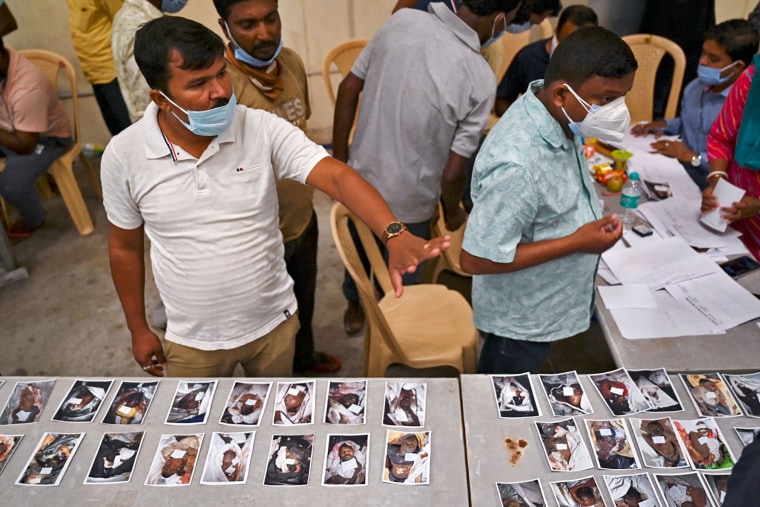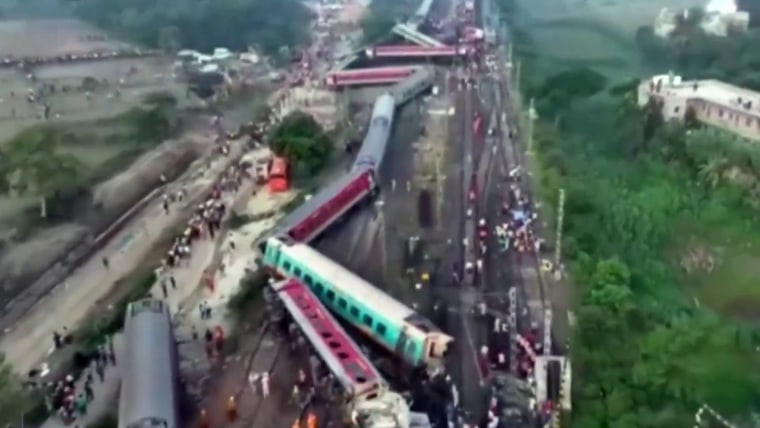A preliminary report signed by railway officials and obtained by NBC News found that a signal was given to the high-speed Coromandel Express to enter the main track line, but that signal was later taken off. The train then entered another line, known as the loop line, and crashed into a goods train parked there.
The incoming Yesvantpur-Howrah Express then crashed into the overturned coaches that had been flipped onto the main line and also derailed, the report said.
Jaya Varma Sinha, a member of the railway board, also gave a similar assessment.
The freight train was loaded with heavy iron ore that meant huge damage to the passenger train that crashed into it, she told a news conference Sunday. She added that the passenger trains, which were carrying 2,296 people total, had not been speeding.
Trains that carry goods are often parked on an adjacent loop line on the side so the main line is clear for a passing train.
Authorities revised the death toll down Sunday to at least 275 people and said about 400 of the 1,175 injured remained hospitalized, a day after rescue efforts to find survivors were halted.
‘Dumbstruck’ by the derailment
The first thing that Anubhav Das remembers seeing after escaping his carriage was hundreds of bodies, and people crying for help with brutal injuries to their arms, legs and heads.
“They were asking for water or any form of bandages, anything that we could give them at that point,” Das, a passenger on the Coromandel Express train heading south from Kolkata to Chennai, told NBC News.
He described making makeshift bandages out of bedsheets from other carriages as young children cried out for their parents.
“At that moment of time, there were headless bodies around, severed arms lying around,” he said, adding that the site was filled with parents who “could not find their children in the dark and in all that rubble,” he said.
Das said he did not fully realize the extent of the disaster he had survived until he turned on his television the next day. “I was actually dumbstruck. I could not even imagine that you could get out of something like this absolutely unscathed,” he added.
Indian Prime Minister Narendra Modi commended citizens who “immersed themselves” in assisting with rescue operations as he visited the site of the disaster Saturday.
Modi said the government would do its utmost to help those who had suffered from the accident and strictly punish anyone found responsible.

The derailment has raised new questions about Modi’s effort to upgrade and modernize a British colonial-era railroad network that is still beset by deadly accidents. The government has spent billions in an effort to make India’s rail 100% electric by 2024, the same year he faces an election.
Previous train accidents have been blamed on human error, or the use of outdated signaling equipment.
“The system is 99.9% error free. But 0.1% chances are always there for an error,” Varma Sinha said Sunday. She added that although the root cause of the crash was related to an error in the electronic signaling system, a detailed investigation would reveal whether the error was technical or human. To a question whether the crash could be a case of sabotage, she said “nothing is ruled out.”
Modi has been invited to address a joint session of Congress during an official state visit to the United States later this year.
President Joe Biden said in a statement late Saturday that “Jill and I are heartbroken by the tragic news of the deadly train crash in India.”
He added: “Our prayers go out to those who have lost loved ones and the many who suffered injuries in this terrible incident.”
Ravi Mishra reported from New Delhi, and Leila Sackur reported from London.
Associated Press and Meagan Fitzgerald contributed.







